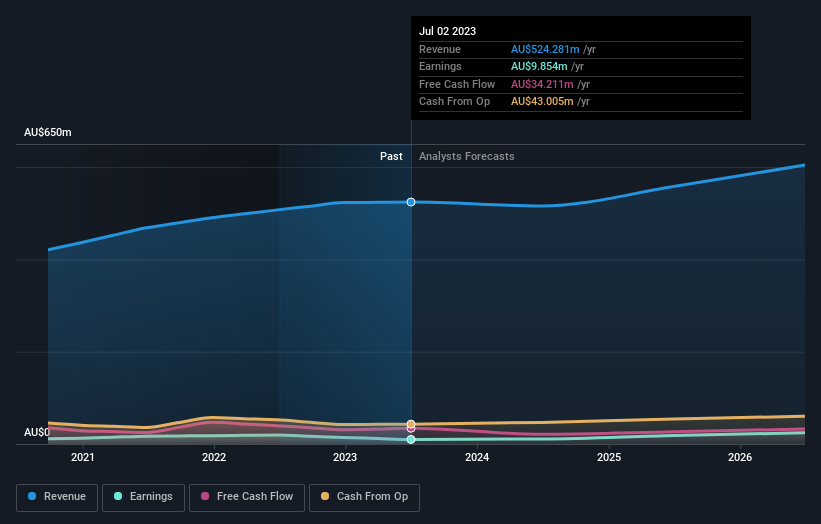- Australia
- /
- Specialty Stores
- /
- ASX:BBN
In the wake of Baby Bunting Group Limited's (ASX:BBN) latest AU$22m market cap drop, institutional owners may be forced to take severe actions

Key Insights
- Institutions' substantial holdings in Baby Bunting Group implies that they have significant influence over the company's share price
- A total of 13 investors have a majority stake in the company with 50% ownership
- Using data from analyst forecasts alongside ownership research, one can better assess the future performance of a company
A look at the shareholders of Baby Bunting Group Limited (ASX:BBN) can tell us which group is most powerful. The group holding the most number of shares in the company, around 50% to be precise, is institutions. Put another way, the group faces the maximum upside potential (or downside risk).
And institutional investors saw their holdings value drop by 10.0% last week. This set of investors may especially be concerned about the current loss, which adds to a one-year loss of 40% for shareholders. Often called “market movers", institutions wield significant power in influencing the price dynamics of any stock. As a result, if the downtrend continues, institutions may face pressures to sell Baby Bunting Group, which might have negative implications on individual investors.
In the chart below, we zoom in on the different ownership groups of Baby Bunting Group.
See our latest analysis for Baby Bunting Group

What Does The Institutional Ownership Tell Us About Baby Bunting Group?
Many institutions measure their performance against an index that approximates the local market. So they usually pay more attention to companies that are included in major indices.
We can see that Baby Bunting Group does have institutional investors; and they hold a good portion of the company's stock. This suggests some credibility amongst professional investors. But we can't rely on that fact alone since institutions make bad investments sometimes, just like everyone does. It is not uncommon to see a big share price drop if two large institutional investors try to sell out of a stock at the same time. So it is worth checking the past earnings trajectory of Baby Bunting Group, (below). Of course, keep in mind that there are other factors to consider, too.

Hedge funds don't have many shares in Baby Bunting Group. Australian Super Pty Ltd is currently the largest shareholder, with 13% of shares outstanding. In comparison, the second and third largest shareholders hold about 10% and 5.9% of the stock.
Looking at the shareholder registry, we can see that 50% of the ownership is controlled by the top 13 shareholders, meaning that no single shareholder has a majority interest in the ownership.
While it makes sense to study institutional ownership data for a company, it also makes sense to study analyst sentiments to know which way the wind is blowing. Quite a few analysts cover the stock, so you could look into forecast growth quite easily.
Insider Ownership Of Baby Bunting Group
While the precise definition of an insider can be subjective, almost everyone considers board members to be insiders. Company management run the business, but the CEO will answer to the board, even if he or she is a member of it.
Most consider insider ownership a positive because it can indicate the board is well aligned with other shareholders. However, on some occasions too much power is concentrated within this group.
We can see that insiders own shares in Baby Bunting Group Limited. As individuals, the insiders collectively own AU$7.2m worth of the AU$200m company. It is good to see some investment by insiders, but we usually like to see higher insider holdings. It might be worth checking if those insiders have been buying.
General Public Ownership
The general public, who are usually individual investors, hold a 46% stake in Baby Bunting Group. While this size of ownership may not be enough to sway a policy decision in their favour, they can still make a collective impact on company policies.
Next Steps:
It's always worth thinking about the different groups who own shares in a company. But to understand Baby Bunting Group better, we need to consider many other factors. Case in point: We've spotted 2 warning signs for Baby Bunting Group you should be aware of.
But ultimately it is the future, not the past, that will determine how well the owners of this business will do. Therefore we think it advisable to take a look at this free report showing whether analysts are predicting a brighter future.
NB: Figures in this article are calculated using data from the last twelve months, which refer to the 12-month period ending on the last date of the month the financial statement is dated. This may not be consistent with full year annual report figures.
Valuation is complex, but we're here to simplify it.
Discover if Baby Bunting Group might be undervalued or overvalued with our detailed analysis, featuring fair value estimates, potential risks, dividends, insider trades, and its financial condition.
Access Free AnalysisHave feedback on this article? Concerned about the content? Get in touch with us directly. Alternatively, email editorial-team (at) simplywallst.com.
This article by Simply Wall St is general in nature. We provide commentary based on historical data and analyst forecasts only using an unbiased methodology and our articles are not intended to be financial advice. It does not constitute a recommendation to buy or sell any stock, and does not take account of your objectives, or your financial situation. We aim to bring you long-term focused analysis driven by fundamental data. Note that our analysis may not factor in the latest price-sensitive company announcements or qualitative material. Simply Wall St has no position in any stocks mentioned.
About ASX:BBN
Baby Bunting Group
Engages in the retail of maternity and baby goods in Australia and New Zealand.
Reasonable growth potential with mediocre balance sheet.


